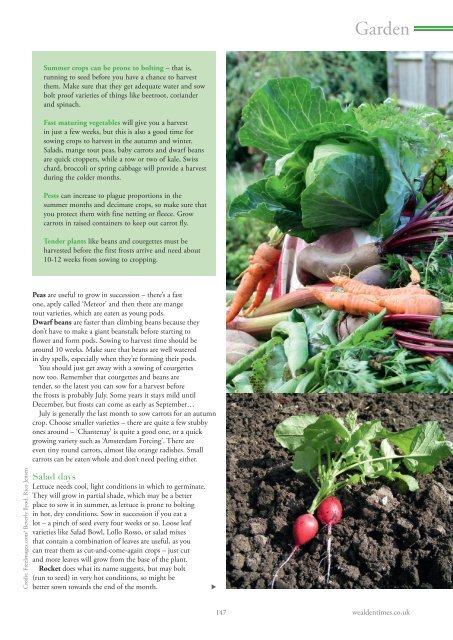Surrey Homes | SH33 | July 2017 | Interiors supplement inside
The lifestyle magazine for Surrey - Inspirational Interiors, Fabulous Fashion, Delicious Dishes
The lifestyle magazine for Surrey - Inspirational Interiors, Fabulous Fashion, Delicious Dishes
Create successful ePaper yourself
Turn your PDF publications into a flip-book with our unique Google optimized e-Paper software.
Garden<br />
Summer crops can be prone to bolting – that is,<br />
running to seed before you have a chance to harvest<br />
them. Make sure that they get adequate water and sow<br />
bolt proof varieties of things like beetroot, coriander<br />
and spinach.<br />
Fast maturing vegetables will give you a harvest<br />
in just a few weeks, but this is also a good time for<br />
sowing crops to harvest in the autumn and winter.<br />
Salads, mange tout peas, baby carrots and dwarf beans<br />
are quick croppers, while a row or two of kale, Swiss<br />
chard, broccoli or spring cabbage will provide a harvest<br />
during the colder months.<br />
Pests can increase to plague proportions in the<br />
summer months and decimate crops, so make sure that<br />
you protect them with fine netting or fleece. Grow<br />
carrots in raised containers to keep out carrot fly.<br />
Tender plants like beans and courgettes must be<br />
harvested before the first frosts arrive and need about<br />
10-12 weeks from sowing to cropping.<br />
Peas are useful to grow in succession – there’s a fast<br />
one, aptly called ‘Meteor’ and then there are mange<br />
tout varieties, which are eaten as young pods.<br />
Dwarf beans are faster than climbing beans because they<br />
don’t have to make a giant beanstalk before starting to<br />
flower and form pods. Sowing to harvest time should be<br />
around 10 weeks. Make sure that beans are well watered<br />
in dry spells, especially when they’re forming their pods.<br />
You should just get away with a sowing of courgettes<br />
now too. Remember that courgettes and beans are<br />
tender, so the latest you can sow for a harvest before<br />
the frosts is probably <strong>July</strong>. Some years it stays mild until<br />
December, but frosts can come as early as September…<br />
<strong>July</strong> is generally the last month to sow carrots for an autumn<br />
crop. Choose smaller varieties – there are quite a few stubby<br />
ones around – ‘Chantenay’ is quite a good one, or a quick<br />
growing variety such as ‘Amsterdam Forcing’. There are<br />
even tiny round carrots, almost like orange radishes. Small<br />
carrots can be eaten whole and don’t need peeling either.<br />
Credit: FreeImages.com/ Beverly llyod, Rico Jensen<br />
Salad days<br />
Lettuce needs cool, light conditions in which to germinate.<br />
They will grow in partial shade, which may be a better<br />
place to sow it in summer, as lettuce is prone to bolting<br />
in hot, dry conditions. Sow in succession if you eat a<br />
lot – a pinch of seed every four weeks or so. Loose leaf<br />
varieties like Salad Bowl, Lollo Rosso, or salad mixes<br />
that contain a combination of leaves are useful, as you<br />
can treat them as cut-and-come-again crops – just cut<br />
and more leaves will grow from the base of the plant.<br />
Rocket does what its name suggests, but may bolt<br />
(run to seed) in very hot conditions, so might be<br />
better sown towards the end of the month.<br />
<br />
147 wealdentimes.co.uk


















